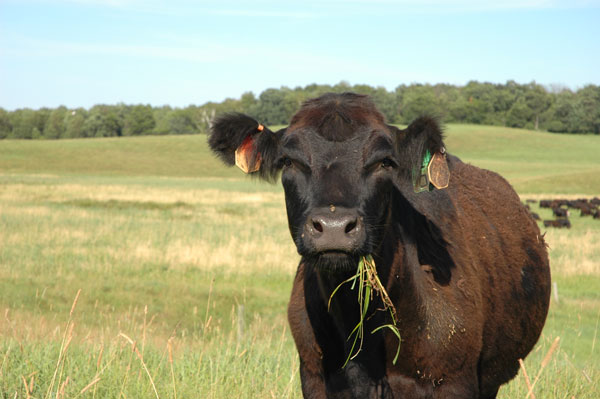Balance nutrition to maximize rumen function and cow performance.
November 7, 2019

Cows are often referred to as upcyclers because they convert grass, something with minimal nutritional value to humans, into an incredibly nutrient-dense food that people like to eat—beef. But what if we could make our cows even more efficient upcyclers?
We’ve learned through years of research that we can manipulate the rumen to double or triple rumen microbe populations in a cow with a balanced nutrition program. More rumen microbes can digest more forage and deliver more energy and protein to the cow. Providing the best nutrition to help rumen microbes thrive is easier said than done, though.
We covered the basics of rumen microbes in a previous BEEF article, so in this article, we’ll go deeper and explore how we can feed cattle to maximize rumen function.
A balancing act
Building thriving rumen microbe populations is a balancing act. You have to balance nutrition based on available forages, weather, environment and operation goals.
Many cattle producers around the country dealt with an abnormally wet growing season on their hay fields this year. While many might have plenty of hay tonnage and plentiful, green pastures, those forages likely lack in other areas, like protein. Filling in that protein gap will help to balance the diet and keep microbes thriving.
Providing a self-fed supplement for cows to access while grazing is a great place to start; cows can access additional nutrition when forages aren’t cutting it. Supplementation also encourages more frequent meals, which helps stabilize rumen pH and stimulates microbe proliferation.
The result? Cows can more efficiently convert forages into energy and better use low-quality feedstuffs, such as stockpiled grass in the winter.
Give diet changes time
Fast diet changes and inconsistencies can wreak havoc on rumen function. They can cause a significant drop in pH and kill off more than half of the rumen microbe population in a hurry. Figure 1 demonstrates microbes before and after a rumen pH change.

I often get asked, "How long does it take the rumen microbe population to adjust and return to normal after a diet change?"
It’s easy to assume a cow’s rumen has fully recovered after 10 to 14 days based on a visual appraisal. It actually takes three to four weeks, depending on how big the change and the amount of damage caused.
Preventing a diet change is the best-case scenario, but it isn’t always possible. Maybe you need to swap a feed ingredient, or perhaps you’re switching hay types.
Fortunately, rumen microbes can adapt to nearly anything, it just takes time for them to adjust. Diet change should be introduced slowly and intentionally over a few days or even weeks, depending on how significant it is.
Detecting poor rumen function
Even if you’re doing everything right, it’s still important to keep your eyes peeled for signs of poor rumen performance.
Feedlot cattle have visible signs of poor rumen function – a drop in feed intake, a change in manure scores, lower gains and more. Cows experiencing poor rumen function are harder to detect. However, every day a cow’s rumen isn’t functioning at maximum efficiency, her performance is compromised.
For example, if a cow is grazing pasture with adequate energy and protein, but inadequate mineral, her rumen microbes will be thrown off balance. Her milk production may drop within as few as 48 hours as her mineral stores are depleted. The chain reaction continues when her calf isn’t consuming as much milk and ultimately doesn’t reach its full weaning weight potential.
Ensure cows don’t have a bad day by paying attention to detail. Keep tabs on how much feed you have, how long your feed supply will last and feed quality to keep diets as consistent as possible. Plan to make diet changes slowly and intentionally.
Rumen microbes are the “herd within your herd.” Set your microbe herd up for success by working with your nutritionist to develop a consistent nutrition plan.
Perry is a cattle nutritionist with Purina Animal Nutrition. Source: Purina Animal Nutrition, which is solely responsible for the information provided and is wholly owned by the source. Informa Business Media and all its subsidiaries are not responsible for any of the content contained in this information asset.
You May Also Like



